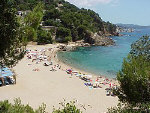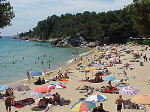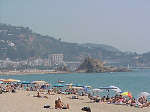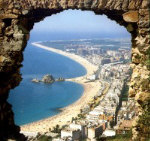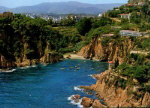
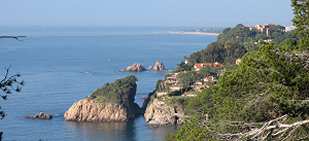 | Le site web de Blanes | 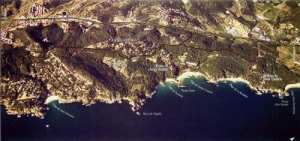 |
Blanes has 5 attractive sand beaches:

|
|
 |
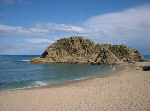 Blanes beach |
History of BlanesIt is possible that human life has existed in the area currently known as Blanes since the third century BC, geographically somewhere between Empuries and Barcelona, along the banks of the Larnum River. With the Romanizing of the land, after 218 BC, the settlement came to be known as Blanda or Blandae. Archaeological excavations place the settlement in the area of "la Penya dels Padrets", where several houses, dating to the first century BC and inhabited up to the middle of the first century AD, have been unearthed. After the fall of the Roman Empire and the advent of the Visigoths, the town suffered several Moorish incursions at the end of the 8th century. It also suffered the passing of the Franks, later becoming a feudal dependence. The earliest mention of Blanes or Forcadell Castle is dated in 1002, and towards the end of 1050 his successors, the Cabreras, are known to have Counts of Barcelona. With the Cabreras, from the 12th to the 14th century, the townsfolk came under the rule of the noble Blanes family. In the 12th century, the feudal lords Guerau IV de Cabrera and his deputy, Guillem de Blanes, granted the port and town of Blanes a series of privileges and rights to encourage settlement and economic growth. From 1381 onwards, the Cabreras, as the sole lords of the township, fostered a series of architectural transformations and town planning changes: In the 15th century the municipal system was consolidated and the rules for the "honourable government of the University" or Town Council, the body from which our modern day Town Councils derive, were established. In 1583, thanks to the initiative of the town councils, a group of Capuchin monks founded a monastery, still to be seen on the Santa Anna promontory. Blanes was also greatly affected by the wars of the 17th century. During the "Harvesters' War" (1652), Blanes was set ablaze by the Castilian troops. And, in 1694, the town was again burnt down and the Viscount's Palace razed. After the War of Succession (1714), the local economy entered into a period of growth and records show extensive maritime-fishery, boat building- and industrial (lacework - rope making - cork - barrel making...) activities. During the course of the century, the town made a significant demographic leap forwards, 1993 inhabitants at the beginning of the century and 3783 at the end. Towards the close of the century (1793), the votive festival of Sant Rafael was first instituted, to thank the "Mare de Déu del Vilar" for having saved the town from the Great War. Some years later, during the war with the French (1808-14), Blanes was used by the French as their headquarters when preparing to attack the fortress at Hostalric. It is from this period that we find the earliest records of the townsfolk refusing to pay their feudal levies, a symbol of the new times and the swan song of the old regime. The last Lord of the town was the Duke of Medinacelli. The town's high level of maritime activity led to the opening of a school for pilots, coinciding with the heyday of the town's shipyards, the largest on the northern Catalan coast through to the end of the century. Technical innovations, such as the coming of the railway (1859), gas lighting (1881) and the first electrical grid (1889) favoured the growth of Blanes. Despite all of this, the end of the century was marked by a crisis in the ship building trade, the vineyards and by emigration to the Americas. The beginning of the 20th century was marked by the opening of the docks (1916) and the founding of the (now Nylstar) SAFA-factory (1923), decisive elements in the restructuring of the town's economy. As far as the social life of the town was concerned, many recreational clubs and groups were formed alongside an important workers movement, one which still lives on today. It was at this time that the Botanical Gardens were initially laid (1924) and the fishing fleet modernised with the fitting of internal combustion engines. During the Spanish Civil War (1936-1939), the town suffered bombing, famine and, moreover, afterwards, there were deep divisions between the "victors" and the "vanquished". Shortages were to continue into the postwar period, accompanied by the total repression of anything considered to be contrary to the interests of the regime. After the political openness in the 50's two important phenomena occurred: the arrival of the first tourists from abroad and large-scale immigration from other parts of Spain, leading to the doubling of the town's population between 1955 and 1970. |
|
|
Botanical Garden |
 Botanical Garden |
|
Blanes has two botanical gardens,
the famous Mar i murtra and the Jardí de Pinya de Rosa, with over 7,000
species of tropical plants, mostly cacti, and a collection of 600 different
types of nopals, or prickly pears. The grounds extend over almost 15 hectares (of which 5 are accessible to the public, entrance fee 300Pts) and were acquired by its founder Karl Faust in 1924. The most notable characteristics of the garden are its collections of cacti and other crass plants from the arid regions of South Africa and Central America. In the pergola you will find a group of sub tropical plants with exuberant foliage. There are also collections of palm trees, cypresses, eucalyptus and araucarias followed by a large variety of perennial bushed and plants belonging to a great number of botanic families from all over the world thus giving a wide vision of the enormous diversity of vascular plants. Of great interest are also the large freshwater pond which holds the aquatic plant collection. Various recently created sections have been classified thus increasing the didactic value of Mar i Murtra. Among these sections are those of the poisonous plants, medicinal and aromatic plants, examples showing the Mendel Laws of Heritage, examples of morphological convergence and an enclosure concentrating on the regional flora and a collection of ferns from the Catalonian mountains. Complementing these collections of living plants are a small herbarium, seed collections, a specialised library, a hothouse, experimental beds and a meteorological station. |
|
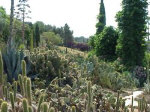 Marimurtra Blanes |
